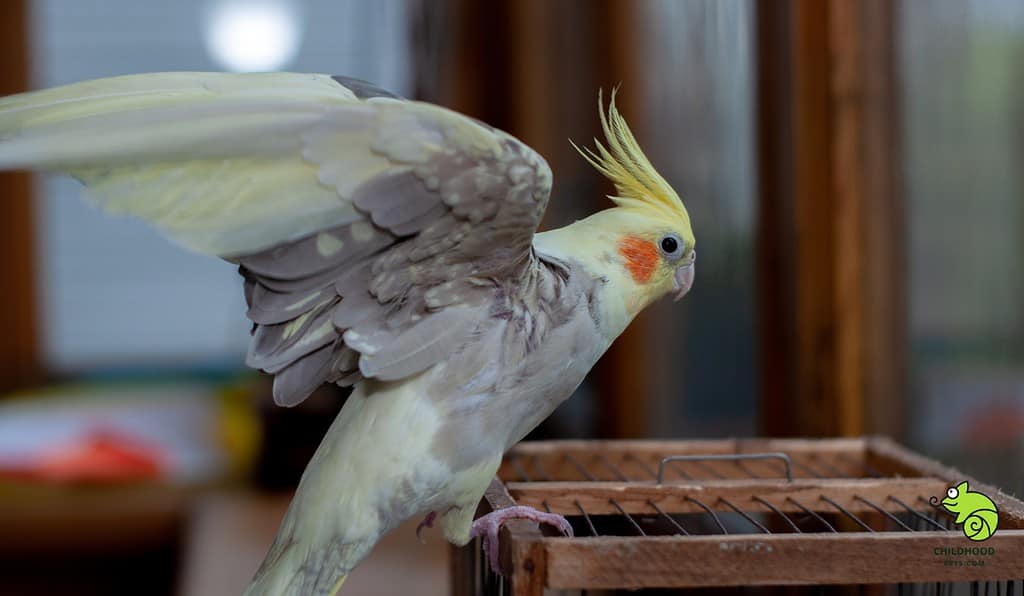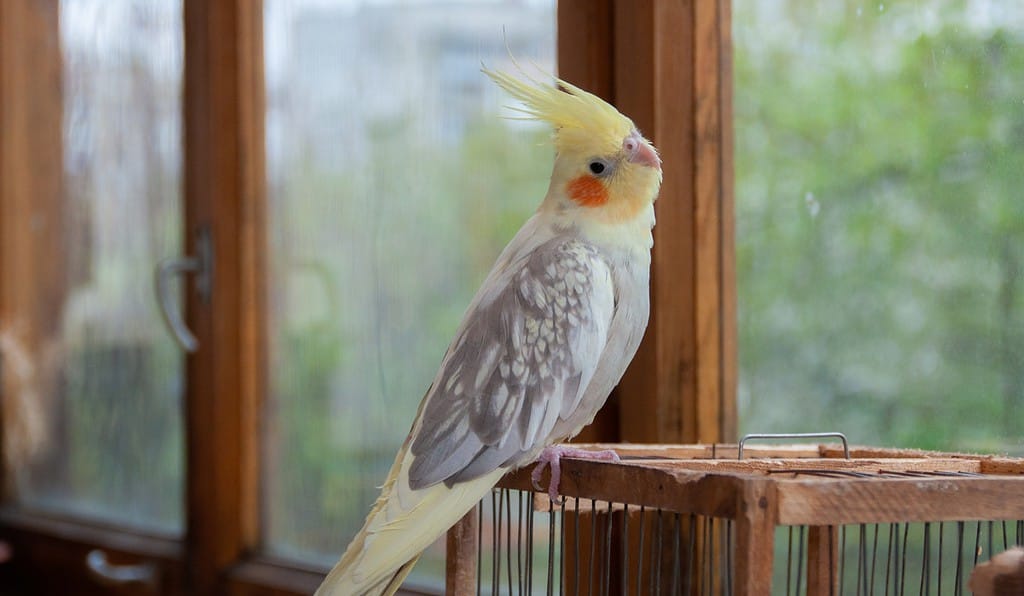
Feathers are more than just a bird’s aesthetic appeal; they’re a testament to its health, mood, and overall well-being. For many cockatiel owners, the sight of a bare patch or a fallen feather can be a cause for concern. After all, these vibrant birds are known for their striking plumage. So, the burning question on many bird enthusiasts’ minds is, do these feathers grow back?
As a general rule, cockatiels do regrow their feathers, especially after natural molting or minor accidents. However, the regrowth process can vary, taking anywhere from a few months to several years, depending on the bird’s health and environment.
Curious about the intricacies of cockatiel feathering? From understanding molting behaviors to the significance of preening, dive into this comprehensive guide.
How Long It Takes for Feathers To Regrow?
The time it takes for feathers to regrow varies depending on the species, the type of feather, and the individual bird’s health and age. Generally, smaller feathers like those on the head and neck can regrow within a few weeks, while larger flight feathers on the wings and tail may take several months to fully regenerate. It’s essential for cockatiels to maintain their plumage for optimal health, flight, and insulation.
Below is a table that provides a glimpse into the average time it takes for feathers to regrow under different circumstances
| Circumstance | Average Regrowth Time |
| Molting | 4-6 weeks |
| Plucking | 6-8 weeks |
| Disease Recovery | 8-12 weeks |
| Injury Recovery | 8-12 weeks |
| Stress Reduction | 6-8 weeks |
The pace at which these feathers make their comeback can be influenced by a myriad of factors. Here are some of the prominent ones:
- Diet: A nutritious diet enriched with proteins, vitamins, and minerals is paramount for speedy feather regrowth.
- Age: Younger birds tend to regrow feathers faster than their older counterparts.
- Health: Healthy birds without underlying medical conditions are likely to regrow feathers quicker.
- Stress Levels: Stress can significantly hamper the speed of feather regrowth. Ensuring a serene environment for your cockatiel is crucial.
- Genetics: Some birds are naturally predisposed to faster feather regrowth owing to their genetic makeup.
Cockatiel Behavior and Feathering

Cockatiels, with their vibrant personalities and striking feathers, are a joy to have around. But, like all birds, they have unique behaviors and needs when it comes to their plumage. Let’s delve into some of these behaviors and understand them better.
1. Cockatiel Molting Behavior
Molting is a natural process where birds shed old feathers to make way for new ones. During this period, cockatiels might seem a bit off their usual energetic selves. They can feel exhausted during molting. Their bodies are working overtime to grow new feathers, which can be taxing. They might also feel exposed and uncomfortable, especially if they lose a significant number of feathers at once. During molting, cockatiels require more energy, protein, and vitamins to support the growth of new feathers.
Energy and nutrient requirements during molt:
| Period | Energy Requirement | Protein Requirement | Vitamin Requirement |
| Molting | High | High | High |
| Growth | Medium | High | Medium |
| Regular | Normal | Normal | Normal |
2. Cockatiel Preening Habits
Preening is an essential behavior for cockatiels. It helps them to keep their feathers clean and neat. It’s a sign of contentment and comfort. Regular preening also helps in removing dirt and parasites.
Importance of regular preening:
- Maintains feather health: Regular preening ensures that feathers are free from dirt and parasites.
- Enhances comfort: Preening helps in aligning feathers, ensuring the bird is comfortable.
- Indicates good health: A bird that preens regularly is typically in good health.
- Boosts appearance: Preened feathers look vibrant and beautiful.
- Promotes bonding: Birds often preen each other, strengthening their bond.
3. Feather Plucking in Cockatiels
Feather plucking can be distressing for both the cockatiel and the owner. It’s essential to understand its causes and how to prevent it.
Causes and prevention:
- Disease or Allergy: Feather plucking can be a sign of an underlying health issue. Regular vet check-ups can help in early detection and treatment.
- Boredom: Ensure your cockatiel has enough toys and gets regular interaction to prevent boredom.
- Nutritional Deficiencies: A balanced diet is crucial. Ensure your bird gets all the necessary nutrients.
- Environmental Stress: A noisy or chaotic environment can stress birds. Ensure their cage is placed in a calm location.
- Lack of Bathing Opportunities: Regular baths can prevent itchy skin, reducing the urge to pluck.
Why Cockatiels Lose Feathers?
Feather shedding in cockatiels isn’t just a casual occurrence; it’s a narrative that paints a vivid picture of their health, lifestyle, and the changing seasons.
Reasons behind feather loss in cockatiels, some of which you might find surprising:
- Natural Molting: Cockatiels naturally shed feathers during molting, typically once or twice a year.
- Stress: Changes in environment or routine can cause excessive feather loss.
- Poor Diet: An unbalanced diet can lead to malnutrition and impact feather health.
- Skin Infections: Fungal or bacterial infections can cause feather loss.
- External Parasites: Mites or lice can lead to feather damage and loss.
- Behavioral Issues: Feather plucking can arise from boredom, anxiety, or other behavioral challenges.
- Injuries: Broken or blood feathers (feathers with an active blood supply) can cause pain and might need vet care.
Frequency of Molting
Throughout my years of practice, one thing that new bird owners frequently ask me is about the frequency of their cockatiels molting. Let me break it down for you:
- Regular Molting: Cockatiels, like many birds, shed their feathers regularly. It’s a natural process that helps them get rid of old, worn-out feathers and make way for fresh ones.
- Major Molts: Cockatiels experience major molts once or twice a year. During these times, they’ll shed a significant number of feathers, especially from their tails and wings.
- First Molt: The first molt for cockatiels typically occurs between 6 and 12 months of age. It’s like their transition from adolescence to adulthood, in feather terms!
- Accidental Loss: Sometimes, a cockatiel might lose a feather unexpectedly, especially if they’re startled or trying to escape a predator. It’s a defense mechanism. Imagine a predator getting a mouthful of feathers while the bird makes its escape!
- Health-Related Loss: Poor nutrition can lead to unhealthy feathers, making them more prone to falling out. If your bird is on a seed-only diet, it might be time to reconsider their nutrition.
What Happens if a Cockatiel Loses Feathers?
Seeing a bald spot on your cherished cockatiel can be worrying. Feather loss, whether it’s a few falling out or a clear patch, gives clues about your bird’s health, surroundings, and maybe its feelings. Let’s explore what feather loss in a cockatiel means for its health and behavior.
- Health Indicators: Often, feather loss can be an early indicator of health issues such as skin infections or internal diseases. Regular vet check-ups can aid in nipping the budding issue before it blossoms into a serious concern.
- Temperature Regulation: Feathers act as insulation. Without enough plumage, your cockatiel might struggle to maintain its body temperature, especially during colder days.
- Flight and Balance: Feathers play a pivotal role in flight and balance. Losing them, especially tail feathers, can hamper your bird’s ability to move around adeptly.
- Social Interaction: In the wild, a well-groomed plumage is often a sign of a healthy bird, attractive for social interactions and mating. Though domesticated cockatiels live a much more protected life, the essence of this social interaction can still ring true.
Conclusion
Understanding our feathered friends, especially their behaviors related to feathering, is crucial for any bird enthusiast or potential bird owner. Throughout my years as a vet, I’ve seen the joy these birds bring to families and the concerns that arise when something seems amiss. Remember, a bird’s feathers are not just for show; they tell a story about its health, comfort, and well-being.
Did you enjoy the article? I’d love to hear your thoughts in the comments below. If you found this information valuable, please consider sharing the article with fellow bird enthusiasts. Your feathered friends will surely appreciate it!
Frequently Asked Questions
Can a Cockatiel fly with missing tail feathers?
If a cockatiel is missing its tail feathers, its ability to balance and steer in the air might be compromised. However, missing tail feathers won’t completely prevent a cockatiel from flying.
Is it normal for cockatiels to lose tail feathers?
Yes, it is normal for cockatiels to lose tail feathers. This process is called molting, and it’s a natural occurrence for birds. Molting allows birds to replace old, worn-out feathers with new ones.
What do unhealthy cockatiel feathers look like?
Unhealthy feathers can appear dry, raggedy, and dirty.
Why do cockatiels pull their feathers out?
It can be due to diseases, allergies, environmental stress, or nutritional deficiencies.
